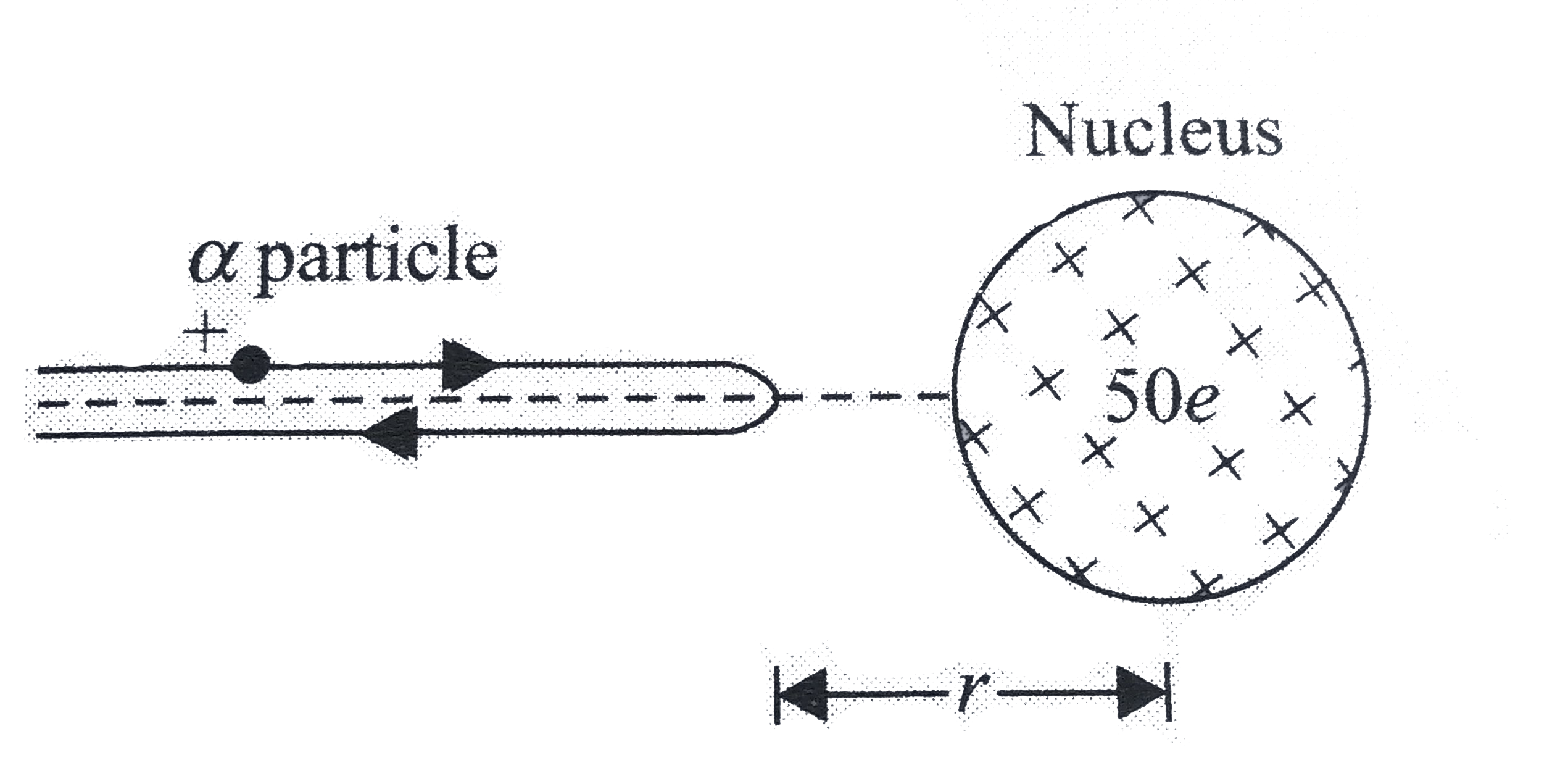An α- particle moving with initial kinetic energy K towards a nucleus of atomic number z approaches a distance 'd' at which it reverse its direction. Obtain the expression for the distance of closest approach 'd' in terms of the kinetic energy of α- particle K.
To find the distance of closest approach d for an alpha particle moving towards a nucleus of atomic number z with initial kinetic energy K, we can use the conservation of energy principle. Here’s a step-by-step solution:
Step 1: Understand the System
An alpha particle has a charge of +2e and is approaching a nucleus with charge +Ze (where Z is the atomic number of the nucleus). As the alpha particle approaches the nucleus, it experiences a repulsive electrostatic force due to the positive charges.
Step 2: Initial Conditions
At a large distance (effectively at infinity), the potential energy is zero, and the kinetic energy of the alpha particle is K:
Ui=0,Ki=K
Step 3: Conditions at Closest Approach
At the distance of closest approach d, the alpha particle comes to a momentary stop, meaning its kinetic energy becomes zero:
Uf=U(d),Kf=0
Step 4: Calculate Potential Energy at Distance d
The potential energy U between two point charges is given by:
U=k⋅q1⋅q2r
For our case, the potential energy at distance d is:
U(d)=k⋅(2e)⋅(Ze)d=2Zke2d
where k is Coulomb's constant.
Step 5: Apply Conservation of Energy
According to the conservation of energy:
Ki+Ui=Kf+Uf
Substituting the values we have:
K+0=0+U(d)
This simplifies to:
K=2Zke2d
Step 6: Solve for Distance d
Rearranging the equation to solve for d:
d=2Zke2K
Final Expression
Thus, the expression for the distance of closest approach d in terms of the kinetic energy K of the alpha particle is:
d=2Zke2K
An alpha particle has a charge of +2e and is approaching a nucleus with charge +Ze (where Z is the atomic number of the nucleus). As the alpha particle approaches the nucleus, it experiences a repulsive electrostatic force due to the positive charges.
At a large distance (effectively at infinity), the potential energy is zero, and the kinetic energy of the alpha particle is K:
Ui=0,Ki=K
At the distance of closest approach d, the alpha particle comes to a momentary stop, meaning its kinetic energy becomes zero:
Uf=U(d),Kf=0
The potential energy U between two point charges is given by:
U=k⋅q1⋅q2r
For our case, the potential energy at distance d is:
U(d)=k⋅(2e)⋅(Ze)d=2Zke2d
where k is Coulomb's constant.
According to the conservation of energy:
Ki+Ui=Kf+Uf
Substituting the values we have:
K+0=0+U(d)
This simplifies to:
K=2Zke2d
Rearranging the equation to solve for d:
d=2Zke2K
Thus, the expression for the distance of closest approach d in terms of the kinetic energy K of the alpha particle is:
d=2Zke2K
Topper's Solved these Questions
- XII BOARDSBOOK - XII BOARD PREVIOUS YEAR PAPER ENGLISHCHAPTER - XII BOARDSEXERCISE - SECTION-C
50 Videos
- XII BOARDSBOOK - XII BOARD PREVIOUS YEAR PAPER ENGLISHCHAPTER - XII BOARDSEXERCISE - PHYSICS (Theory) DELHI BOARD -2016 [SET -I][COMPTT.]
11 Videos
- XII BOARDSBOOK - XII BOARD PREVIOUS YEAR PAPER ENGLISHCHAPTER - XII BOARDSEXERCISE - SECTION-A
28 Videos
- SAMPLE PAPER 2019BOOK - XII BOARD PREVIOUS YEAR PAPER ENGLISHCHAPTER - SAMPLE PAPER 2019EXERCISE - SECTION D
6 Videos
Similar Questions
In scattering experiment, find the distance of closest approach, if a 6MeVα−partic≤ is used
View SolutionAn alpha particle with kinetic energy 10MeV is heading toward a stationary tin nucleus of atomic number 50. Calculate the distance of closest approach (Fig . 3.23).
 .
.
View SolutionAn alpha particle with kinetic energy 10MeV is heading toward a stationary tin nuclcus of atomic number 50. Calculate the distance of closest approach (Fig . 3.23).
 .
.
View SolutionIn a Geiger- Marsden experiment, calculate the distance of closest approach to the nucleus of Z=80, when an α particle of 8 Me V energy impinges on it before it comes momentarily to rest and reverses its direction.
How will the distance of closest approach be affected when the kinetic energy of the α− particle is doubled ?
View SolutionIn alpha-particle scattering experiment, the expression of distance of closest approach (r0)is (symbols have their usual meanings)
View SolutionIn a Geiger - Marsden experiment, calculate the distance of closest approach to the nucleus of Z=75, when an α - particle of 5 Me V enery impinges on it before it comes momentarily to rest and reverses its direction.
How will the distance of closest approach be affected when the kinetic energy of the α-particle is doubled ?
View Solution(a) Define the distance of closest approach. A α -particle of kinetic energy K is bombarded on a thin gld foil. The distance of the closest approach is ra. What will be the distance of closest approach for an α-particle of double the kinetic energy ?
(b) Show that the radius of the orbit of an electron in hydrogen atoms varies as n2, where n is the principal quantum number of the atom.
View SolutionThe distance of closest approach of an alpha-particle fired towards a nucleus with momentum p is r. What will be the distance of closest approach when the momentum of alpha-particle is 2p?
View SolutionAn α - particle after passing through a potential difference of V volts collides with a nucleus . If the atomic number of the nucleus is Z then the distance of closest approach of α – particle to the nucleus will be
View SolutionDefine the distance of closest approach. An α-particle of kinetic enegy 'K' is bombarded on a thin gold foil. The distance of the closest approach is 'r' . What will be the distance of closest approach for an α-particle of double the kinetic energy ?
View Solution
